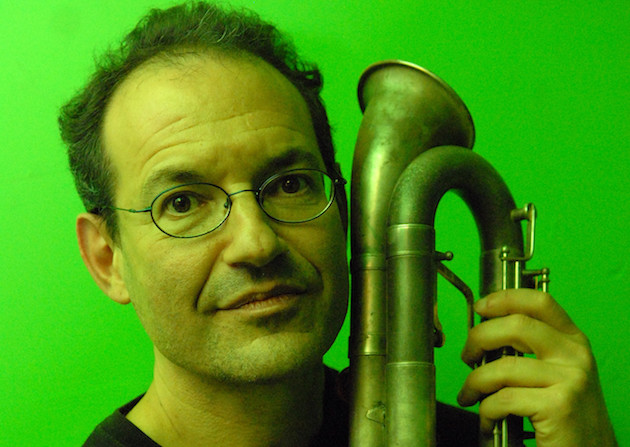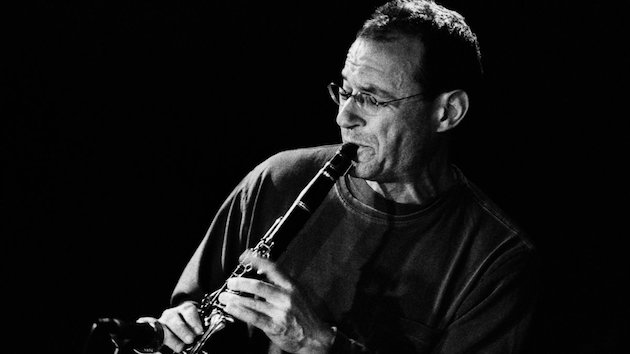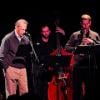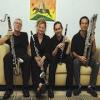
A prolific composer and recording artist in the best of times, Berkeley clarinetist Ben Goldberg has found a potent muse in pandemic-induced seclusion. He’s been composing, recording, and posting a new tune almost every day on Bandcamp since March 19, creating a quietly enthralling body of music that he calls Plague Diary. As that title suggests, delving into his sequestered creations can feel like an intimate encounter with a contemplative soul seeking succor and a moment or two of beauty.
Sheltered in place with his longtime partner Molly Barker, the graphic artist whose paintings and illustrations have graced nearly two dozen Goldberg albums spanning three decades, he’s been rigorously disciplined. Rarely missing a day, he’s posted more than 60 tracks as of May 23, gradually expanding his sonic palette from his primary horn, Bb clarinet, and a lightly employed effects pedal to include keyboards, loops, and lower-register clarinets. Until two weeks ago he was also teaching a course on improvisation at UC Berkeley (online, like all Cal classes after the statewide shelter in place order), and stayed on task “by creating a deadline for myself every day,” he says.
“One resource I’ve drawn on is notebooks where I’ve got tunes I worked on for several years and abandoned. Another source is trying to use the recording process itself as a sketch book. A more typical way to compose for me is sitting at the piano and working it out note by note and chord by chord. I’d never really recorded myself before so this is new to me. There are a lot of dead ends but I feel like I want to be stretched beyond my abilities all the time. Yesterday I generated a dozen ideas but I couldn’t follow through on anything. It’s good to get to that place. Now I’m going to get beyond it.”
The music is all available free via Bandcamp, though Goldberg hopes people will purchase the pieces or otherwise support the endeavor. At this point most of the tracks are titled with the date they were posted, though there are a handful of dedications and evocatively named pieces. April 15’s ethereal “How to Do Things with Tears” is a tune he radically repurposed from his 2013 album Subatomic Particle Homesick Blues with tenor saxophonist Joshua Redman, cornetist Ron Miles, bassist Devon Hoff, and drummers Ches Smith and Scott Amendola.
The pieces he created over the first two weeks average four or five minutes in length, and tend to center on one theme or line that he turns over and examines minutely. By the third week Goldberg is stretching out, and the recordings run closer to 10 minutes. Some tunes burrow down into a theme like he’s trying to work through an idea, but just as often a piece flows to the horizon, as if defying the directive to stay put. By “April 9,” Goldberg delivers an almost 25-minute track that hints at minimalism while meandering around in ever more euphonious cycles.
One of my favorite tracks is “April 17,” a boppish line that seems to devolve as he alters it with a guitar pedal, creating an echoing counterline to shadow his melody. April 20’s “Turkle Dove” opens with a folky Americana theme and resolves into a forthright groove. It’s not until May 1 that he pulls out his formidable contra-alto clarinet, an instrument that’s become a signature Goldberg horn in recent years, with its distinctive subway rumbling cadences. Why did it take so long for him to unleash the beast?
“I’m working hard, but I can also get lazy,” Goldberg says. “Do I really want to get that thing out of the case? Reset the mic? I had that weird guitar pedal from the beginning but I didn’t have the tape looping device until mid-April. I’ve gotten more adept at managing the recording equipment but it wasn’t until a month in that I figured a lot of stuff out. ‘How To Do Things With Tears’ was the first time I could actually put the mic through this guitar pedal then into the recording system. Then I got the looping pedal and I went crazy with that. I’ve learned to dial that back.”
Lazy isn’t a word often associated with Goldberg, an artist whose prepandemic output was expansive, consistently inspired, and extensively consequential. And more than ever his music was gaining notice. After some three decades ensconced in the Bay Area, where his multiple ensembles, projects, and collaborations played an essential role in juicing the region’s creative music scene, Goldberg decided to stretch his wings. Over the past five years he’s spent extended stretches in New York City, renewing and refreshing relationships with players from the Bay Area while forging a vast array of new musical connections.
He seemed to be everywhere as a leader, collaborator, and sideman — most importantly with drummer Allison Miller’s all-star sextet Boom Tic Boom, which was just named mid-size ensemble of the year by the Jazz Journalists Association. Just in the past few years he’s released a half-dozen albums, including a duo album with cornetist Kirk Knuffke, Uncompahgre (Relative Pitch) and a gospel-music inflected sextet session with Ben Goldberg School Vol. 1: The Humanities (Bag Production Records) with the superlative Bay Area cast of accordionist Rob Reich, trombonist Jeff Cressman, alto saxophonist Kasey Knudsen, bassist David Ewell, and drummer Hamir Atwal.
He and New York keyboardist Michael Coleman collaborated with engineer Eli Crews on the Steve Lacy-inspired Practitioner (Bag Production Records), and Goldberg teamed up with the ubiquitous New York tandem of drummer Tomas Fujiwara and guitarist Mary Halvorson on the free-jazz trio session The Out Louds (Relative Pitch). Last year I covered his singular project Good Day for Cloud Fishing with guitarist Nels Cline and cornetist Ron Miles playing Goldberg’s tunes inspired by the poetry of Dean Young (which Young then turned around and wrote verse for) as part of an SFCV piece on jazz and poetry. Before Plague Diary, his most recent release was the digital only Symphony No. 9, a sextet project he cheekily dedicated to “Love Potion No. 9” and “Revolution No. 9,” with Knudsen, Atwal, bassist Rod Adkins, guitarist Andrew Conklin, and tenor saxophonist Chris Speed.
Long a textbook case of the jazz press’s negligence and East Coast myopia, Goldberg couldn’t be ignored much longer. Between his collaborations with high-profile comrades like Nels Cline, Mary Halvorson, and pianist Myra Melford, and his New York City sojourns he’s earned some long overdue coverage. Kevin Whitehead, the jazz reviewer on public radio’s Fresh Air, featured Good Day for Cloud Fishing last September. And in October, JazzTimes magazine ran an “Overdue Ovation” feature on him that keyed on his 60th-birthday celebration at the Stone, John Zorn’s barebones performance space that turns over programming to a different artist every week.
“With the wealth of projects he’s assembled and recorded since his debut with the New Klezmer Trio in 1991, Goldberg could have easily booked his weeklong stint at the Stone at the New School a few times over,” Shawn Brady wrote before noting that Goldberg had instead filled the schedule to the brim with recent and previously untested ensembles encompassing dozens of musicians. Clearly he’s embraced pushing himself to creative extremes. Like many people who lead overly hectic lives, Goldberg wouldn’t have chosen this particular calamity for a respite. But in reflecting on life sheltered in place he finds a silver lining that informs the beatific place he keeps returning to with his Plague Diary pieces. He makes his first foray into live streaming as part of “The Quarantine Concerts” series produced by Chicago’s Experimental Sound Studio on May 31 (he’s scheduled to play at 6:30 p.m. PST), and presents his own solo performance via Facebook Live on June 11, 7 p.m.

“The pandemic hit and within three days I’d lost $6,000 worth of work,” Goldberg says. “I hadn’t even been aware of how busy my schedule was in March and April, and truthfully I was happy it got cancelled. With the pandemic I don’t want to be out there. It made me confront how insanely busy I’ve been, which came to seem like normal life. So this presented a question to me as an artist. If I really believe what I think I believe about the power of art and its importance, then this is a test right now. If art is necessary and useful and contains our most important cultural knowledge, now’s exactly the time to work as hard as I can.”




